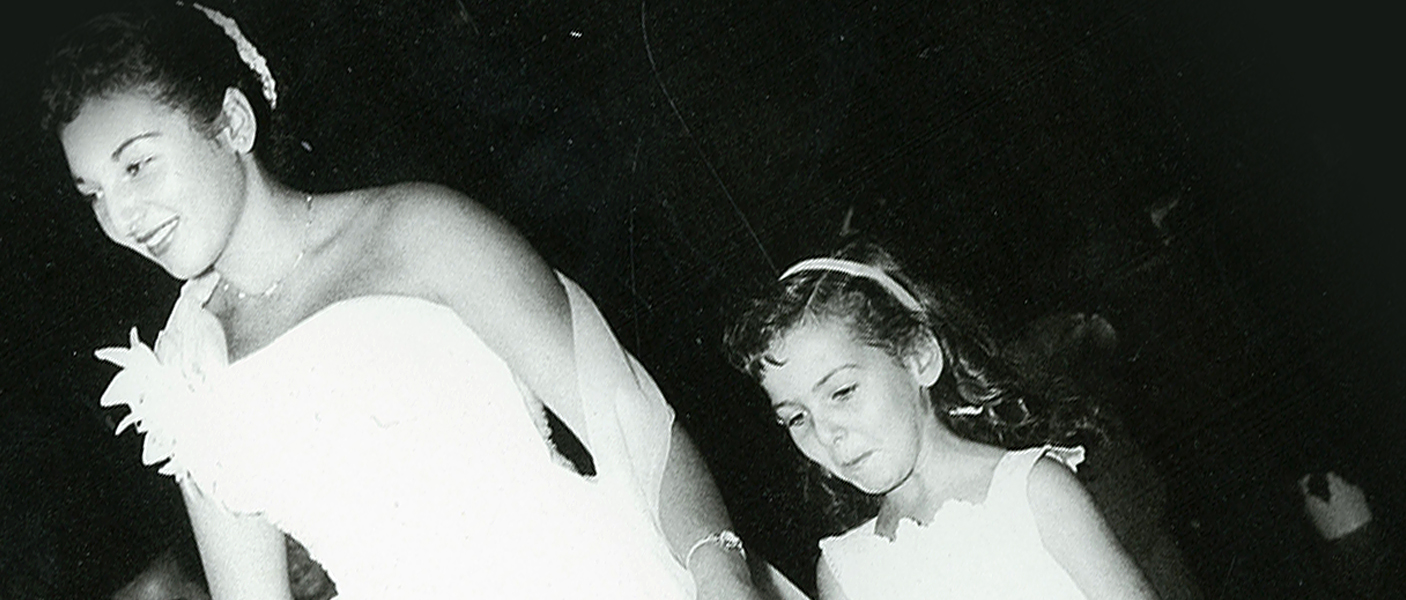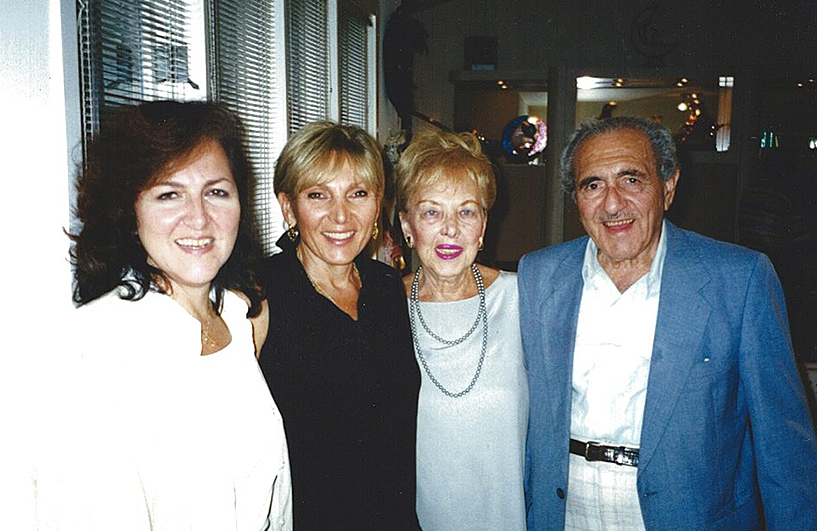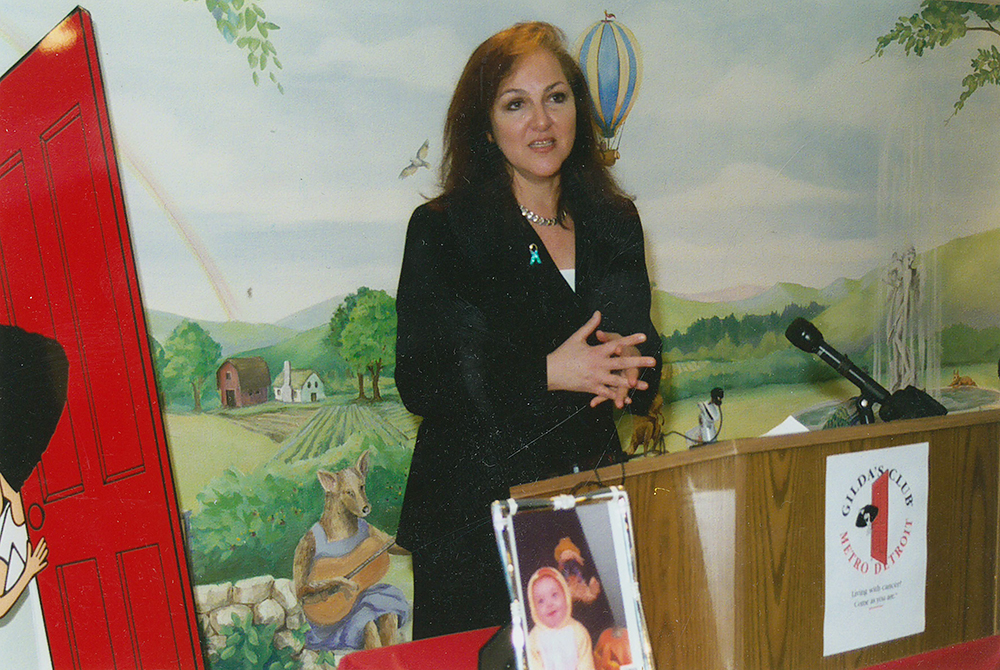

An avid tennis player, Johanna Silver Gordon was incredibly dynamic and outgoing. She taught high school English and humanities and worked at being healthy. She ate a heart-healthy diet and exercised regularly, hoping to fend off heart disease, high blood pressure, and stroke, all of which were known family health issues. In many ways, her sister Sheryl Silver recalls, she was the glue that held her family together. “She was my best friend, confidant, and supporter.”
The entire family was stunned when, in January of 1997, Johanna was diagnosed with late-stage ovarian cancer. “I remember time stopping,” Sheryl recalls. “I thought, ‘This can’t be happening. We’re in deep trouble here.’”
Ovarian cancer hadn’t been on Johanna’s radar. She had complained of persistent bloating at her annual gynecological exam, but her doctor shook it off as a symptom of perimenopause. The bloating intensified and she developed heartburn, so she made an appointment with a gastroenterologist but, as a new patient, it would be a few months before the scheduled appointment. As her symptoms worsened, she decided to follow up with her gynecologist, who finally ordered a CA125 blood test and a transvaginal ultrasound.
A week later, Johanna was in surgery to have cancer removed. She was referred to purchase a wig and started chemotherapy. “Her face just registered this terrible shock. She said she felt very betrayed. She’d always been able to rely on her body,” Sheryl says. “If she thought her symptoms were life-threatening, she would have done more sooner.”
 Sheryl began attending national ovarian cancer conferences in Washington, DC, and later, a Gilda’s Club support group in Michigan with Johanna. Along with her sister, Sheryl immersed herself in research, looking for anything that might save Johanna’s life. It turned out that Johanna’s case was textbook. She was a woman over 50 who had not had multiple pregnancies or used hormonal birth control. She was Ashkenazi Jewish. She had nothing that would lower her risk of ovarian cancer and everything that would increase it. Even not starting menopause by age 54 added to her risk; late menopause is a risk factor for ovarian cancer. Sheryl and Johanna were daughters of a doctor and had always put their faith in medicine. They were appalled at the lack of information on, and monitoring for, ovarian cancer.
Sheryl began attending national ovarian cancer conferences in Washington, DC, and later, a Gilda’s Club support group in Michigan with Johanna. Along with her sister, Sheryl immersed herself in research, looking for anything that might save Johanna’s life. It turned out that Johanna’s case was textbook. She was a woman over 50 who had not had multiple pregnancies or used hormonal birth control. She was Ashkenazi Jewish. She had nothing that would lower her risk of ovarian cancer and everything that would increase it. Even not starting menopause by age 54 added to her risk; late menopause is a risk factor for ovarian cancer. Sheryl and Johanna were daughters of a doctor and had always put their faith in medicine. They were appalled at the lack of information on, and monitoring for, ovarian cancer.
Johanna briefly went into remission after her first surgery and chemotherapy, but her cancer returned. Three more major surgeries and chemo combinations followed along with her efforts to enter clinical trials. Nothing worked and, on August 29, 2000, she died. Within a few months, Sheryl realized that just grieving for her sister was not the way to honor her life. “I’d gone looking for research information that I thought would save her. What I learned, instead, was that her story was tragically common.”
Sheryl, who was a freelance writer and editor at the time, approached The Washington Post about running a special advocacy section on ovarian cancer to educate women about the disease. She reached out to the Gynecologic Cancer Foundation (now known as the Foundation for Women’s Cancer) and secured them as a sponsor. When articles for the section began arriving via email, Sheryl recalls, “I would sit there with tears rolling down my face because it meant so much to me to know that she hadn’t died in vain.” Her idea of educating the public about ovarian cancer was becoming a reality.
 It didn’t stop there. A similar special section on gynecologic cancers which Sheryl edited and for which she also wrote articles followed in the New York Times. Then, knowing that newspaper articles wouldn’t reach everyone who needed the information, Sheryl was inspired to propose a federal law that created a national gynecologic cancer education program. First introduced in the House of Representatives by Michigan Congressman Sander Levin in 2003, Johanna’s Law: The Gynecologic Education and Awareness Act, gained the support of more than 300 bi-partisan co-sponsors and passed both the U.S. House and Senate unanimously on December 8th and 9th, 2006. Signed into law by President George W. Bush in January of 2007, it directed the Centers for Disease Control to create a national education campaign. Sheryl says that working on the law was very healing. “It consumed my life for a few years, but otherwise I would just have had this gigantic hole where my sister had been. Instead, she’s on my mind a lot. I know that she made a difference.”
It didn’t stop there. A similar special section on gynecologic cancers which Sheryl edited and for which she also wrote articles followed in the New York Times. Then, knowing that newspaper articles wouldn’t reach everyone who needed the information, Sheryl was inspired to propose a federal law that created a national gynecologic cancer education program. First introduced in the House of Representatives by Michigan Congressman Sander Levin in 2003, Johanna’s Law: The Gynecologic Education and Awareness Act, gained the support of more than 300 bi-partisan co-sponsors and passed both the U.S. House and Senate unanimously on December 8th and 9th, 2006. Signed into law by President George W. Bush in January of 2007, it directed the Centers for Disease Control to create a national education campaign. Sheryl says that working on the law was very healing. “It consumed my life for a few years, but otherwise I would just have had this gigantic hole where my sister had been. Instead, she’s on my mind a lot. I know that she made a difference.”
In 2009, Sheryl established the Dr. I. Walter and Anne Silver Family Foundation for Ovarian Cancer Research in memory of her parents. Last fall, at the suggestion of a friend in the ovarian cancer community, Sheryl was referred to the Department of Pathology’s Dr. Analisa DiFeo as a potential recipient of funding. DiFeo, who joined the department in the summer of 2018, focuses on identifying novel biomarkers of ovarian cancer therapeutic response and generating novel targeted molecular therapies. These therapies can work with current treatment options or on their own.
Prior to arriving to Ann Arbor, Dr. DiFeo was the Director of the Gynecologic Oncology Translational Research Program at Case Western Reserve University. Through this program, she developed an extensive gynecologic tumor biobank which includes novel primary cancer cell lines and patient-derived mouse models which she was able to transfer to her new laboratory at The University of Michigan. She has now expanded this program to Ann Arbor. Through the Ovarian Cancer Initiative, she will be able to continue her efforts in growing the tumor biobank and utilize this robust and clinically-relevant resource to uncover molecular factors that are involved in ovarian cancer and the development of novel drugs to treat the disease.
Sheryl called DiFeo and was impressed by her passion, compassion, knowledge, and commitment to patient-centered care. “Her clear focus on strategies that could improve patient survival and treatment plans was incredibly compelling and inspiring,” Sheryl says. “She’s a star and the University of Michigan is lucky to have her.”
DiFeo is extremely grateful for the gift explaining that it will allow her lab to pursue projects that are a bit more high-risk-high-reward than funding from more traditional funding agencies, such as the National Institutes of Health, will allow. “Sheryl and her family will now be intimately involved in our scientific endeavors. I am honored that the Silver Family Foundation was able to see that our passions align and we can only make a true impact if we work together.“
“Any health care professional who has ovarian cancer patients needs to keep fighting for them and keep trying. It’s why we love doctors like Dr. DiFeo who have chosen this specialty,” Sheryl says. “We deeply appreciate the commitment to research.”
—
To make your own gift to the Department of Pathology at Michigan Medicine contact Jason Keech at jkeech@umich.edu.
 ON THE COVER
ON THE COVER
Breast team reviewing a patient's slide. (From left to right) Ghassan Allo, Fellow; Laura Walters, Clinical Lecturer; Celina Kleer, Professor. See Article 2014Department Chair |

newsletter
INSIDE PATHOLOGYAbout Our NewsletterInside Pathology is an newsletter published by the Chairman's Office to bring news and updates from inside the department's research and to become familiar with those leading it. It is our hope that those who read it will enjoy hearing about those new and familiar, and perhaps help in furthering our research. CONTENTS
|
 ON THE COVER
ON THE COVER
Autopsy Technician draws blood while working in the Wayne County morgue. See Article 2016Department Chair |

newsletter
INSIDE PATHOLOGYAbout Our NewsletterInside Pathology is an newsletter published by the Chairman's Office to bring news and updates from inside the department's research and to become familiar with those leading it. It is our hope that those who read it will enjoy hearing about those new and familiar, and perhaps help in furthering our research. CONTENTS
|
 ON THE COVER
ON THE COVER
Dr. Sriram Venneti, MD, PhD and Postdoctoral Fellow, Chan Chung, PhD investigate pediatric brain cancer. See Article 2017Department Chair |

newsletter
INSIDE PATHOLOGYAbout Our NewsletterInside Pathology is an newsletter published by the Chairman's Office to bring news and updates from inside the department's research and to become familiar with those leading it. It is our hope that those who read it will enjoy hearing about those new and familiar, and perhaps help in furthering our research. CONTENTS
|
 ON THE COVER
ON THE COVER
Director of the Neuropathology Fellowship, Dr. Sandra Camelo-Piragua serves on the Patient and Family Advisory Council. 2018Department Chair |

newsletter
INSIDE PATHOLOGYAbout Our NewsletterInside Pathology is an newsletter published by the Chairman's Office to bring news and updates from inside the department's research and to become familiar with those leading it. It is our hope that those who read it will enjoy hearing about those new and familiar, and perhaps help in furthering our research. CONTENTS
|
 ON THE COVER
ON THE COVER
Residents Ashley Bradt (left) and William Perry work at a multi-headed scope in our new facility. 2019Department Chair |

newsletter
INSIDE PATHOLOGYAbout Our NewsletterInside Pathology is an newsletter published by the Chairman's Office to bring news and updates from inside the department's research and to become familiar with those leading it. It is our hope that those who read it will enjoy hearing about those new and familiar, and perhaps help in furthering our research. CONTENTS
|
 ON THE COVER
ON THE COVER
Dr. Kristine Konopka (right) instructing residents while using a multi-headed microscope. 2020Department Chair |

newsletter
INSIDE PATHOLOGYAbout Our NewsletterInside Pathology is an newsletter published by the Chairman's Office to bring news and updates from inside the department's research and to become familiar with those leading it. It is our hope that those who read it will enjoy hearing about those new and familiar, and perhaps help in furthering our research. CONTENTS
|
 ON THE COVER
ON THE COVER
Patient specimens poised for COVID-19 PCR testing. 2021Department Chair |

newsletter
INSIDE PATHOLOGYAbout Our NewsletterInside Pathology is an newsletter published by the Chairman's Office to bring news and updates from inside the department's research and to become familiar with those leading it. It is our hope that those who read it will enjoy hearing about those new and familiar, and perhaps help in furthering our research. CONTENTS
|
 ON THE COVER
ON THE COVER
Dr. Pantanowitz demonstrates using machine learning in analyzing slides. 2022Department Chair |

newsletter
INSIDE PATHOLOGYAbout Our NewsletterInside Pathology is an newsletter published by the Chairman's Office to bring news and updates from inside the department's research and to become familiar with those leading it. It is our hope that those who read it will enjoy hearing about those new and familiar, and perhaps help in furthering our research. CONTENTS
|
 ON THE COVER
ON THE COVER
(Left to Right) Drs. Angela Wu, Laura Lamps, and Maria Westerhoff. 2023Department Chair |

newsletter
INSIDE PATHOLOGYAbout Our NewsletterInside Pathology is an newsletter published by the Chairman's Office to bring news and updates from inside the department's research and to become familiar with those leading it. It is our hope that those who read it will enjoy hearing about those new and familiar, and perhaps help in furthering our research. CONTENTS
|
 ON THE COVER
ON THE COVER
Illustration representing the various machines and processing used within our labs. 2024Department Chair |

newsletter
INSIDE PATHOLOGYAbout Our NewsletterInside Pathology is an newsletter published by the Chairman's Office to bring news and updates from inside the department's research and to become familiar with those leading it. It is our hope that those who read it will enjoy hearing about those new and familiar, and perhaps help in furthering our research. CONTENTS
|
 ON THE COVER
ON THE COVER
Rendering of the D. Dan and Betty Khn Health Care Pavilion. Credit: HOK 2025Department Chair |

newsletter
INSIDE PATHOLOGYAbout Our NewsletterInside Pathology is an newsletter published by the Chairman's Office to bring news and updates from inside the department's research and to become familiar with those leading it. It is our hope that those who read it will enjoy hearing about those new and familiar, and perhaps help in furthering our research. CONTENTS
|

MLabs, established in 1985, functions as a portal to provide pathologists, hospitals. and other reference laboratories access to the faculty, staff and laboratories of the University of Michigan Health System’s Department of Pathology. MLabs is a recognized leader for advanced molecular diagnostic testing, helpful consultants and exceptional customer service.